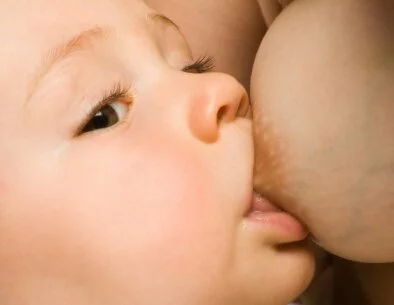Domperidone for Improving Breastmilk Production
What is domperidone?
Domperidone (Motilium) is a peripheral dopamine antagonist generally used for controlling nausea and vomiting, dyspepsia (upset stomach), diabetic gastroparesis (poor stomach emptying which occurs in diabetics) and gastric reflux (heartburn). It blocks peripheral dopamine receptors in the intestinal wall and in the nausea center of the brainstem. Unlike metoclopramide (Reglan), it does not enter the brain compartment to any appreciable degree and has few central nervous system effects (such as depression and tardive dyskinesia with Reglan). (1)
It was developed by Janssen Pharmaceutical Products and first marketed in Belgium in 1978. It is currently approved for use in over 80 countries including the European Union, Australia, New Zealand, Canada, and Mexico. It is available without a prescription (OTC) in several countries, including Belgium, Ireland, Italy, Netherlands, United Kingdom, Switzerland and South Africa.
What are the pharmacokinetics of domperidone?
Domperidone is rapidly absorbed with peak plasma concentration approximately 1 hr after oral administration. It has a low bio-availability (~15%) due to first-pass hepatic and intestinal metabolism. It is 91-93% bound to plasma proteins with a plasma half-life of 7-9 hrs. Concentrations of domperidone reported in human milk do vary with maternal dose, but are extremely low, from 0.28 to 2.6 ug/L milk in various studies, resulting in a negligible mean relative infant dose (RID) of 0.009-0.012% of maternal dose. (1)
Why is domperidone used for breastfeeding/breastmilk-expressing women?
Human milk is a medicine in the NICU, reducing NEC and other infections, and decreasing length of stay and cost. Insufficient milk supply is the number one cause of stopping breastfeeding and is a severe problem in the NICU where mothers often must pump (instead of breastfeeding) for weeks to months. In addition to increased milk expression, galactogogues (substances that increase milk supply) are often used to help mothers maintain and recover their milk supply. Options are herbal galactogogues such as fenugreek (no controlled studies but generally recognized as safe), metoclopramide (Reglan) and domperidone (Motilium). (2) Both metoclopramide and domperidone increase prolactin (the milk-making hormone) secretion from the anterior pituitary, but domperidone appears the safer drug as it rarely causes extrapyramidal (motor nerve) or any side effects. (1, 3)
Does domperidone work to increase milk supply?
There is an abundance of clinical experience and anecdotal reports of improved milk supply with domperidone over the last 30 years. There are now 5 studies (albeit each with small numbers of subjects) which demonstrate clinically insignificant concentrations of domperidone in human milk, no side effects in infants, minimal to no side effects in mothers, and increased milk supply in most mothers. (3-7)
Is domperidone safe?
The American Academy of Pediatrics (AAP) lists domperidone as a drug compatible with breastfeeding. (8) It is also listed in pharmacy resources such as DrugDex and MicroMedex, and as a preferred galactogogue by the Academy of Breastfeeding Medicine.(9) According to the manufacturer, adverse side effects include very rare allergic reactions; very rare extrapyramidal side effects; rare intestinal symptoms including cramps; rare galactorrhea (milk production), gynecomastia (increased breast size) and amenorrhea (lack of menstrual periods). There have been several published reports of cardiac arrhythmias, cardiac arrest, and sudden death in severely ill patients receiving an intravenous form of domperidone. (10) The intravenous form was removed from the market approximately 20 years ago. There are no reports of cardiotoxicity (heart problems) for the oral form of domperidone. Despite this, the Federal Drug Administration (FDA) issued an Alert in June 2004, warning women against the use of domperidone to increase milk production. (11)
Why the FDA alert?
In a phone conference with breastfeeding and pharmacology experts in 2004, the FDA cited 4 issues of concern:
1. Absence of credible scientific data to establish the safety and efficacy of domperidone as a galactogogues data available and dismissed.
2. Domperidone is dangerous for breastfeeding women inappropriately citing deaths of critically ill patients given IV domperidone over 20 years ago.
3. Domperidone may be dangerous to the breastfed infant no evidence to date, and unlikely as clinically insignificant amounts are in breastmilk. Almost all the drugs in the PDR are labeled as not to be used in breastfeeding women for legal, not medical reasons (tests not done as too expensive).
4. The FDA is concerned with unsafe cross border importation of drugs and internet distribution of drugs a legitimate concern, made worse by threatening compounding pharmacies in the US if they provide domperidone with a legitimate prescription.
The FDA asserts that compounding of domperidone is illegal in the US as domperidone is a new drug. This is disputed by the International Association of Compounding Pharmacists (IACP) and legal precedent. Letters sent to compounding pharmacists state: FDA does not sanction its use in pharmacy compounding and will not exercise its enforcement discretion for compounded products containing domperidone. (12) According to Loyd Allen Jr. PhD, Editor-in-Chief of the International Journal of Pharmaceutical Compounding: Compounded drugs, when created for an individual patient pursuant to a prescription from a licensed practitioner, are implicitly exempt from the new drug definitions. (13)
Is domperidone being prescribed today in the US?
Domperidone is in such wide use and acceptance by US gastroenterologists that it is even cited in the medical literature and advice regarding how to obtain it is provided. After the 2004 FDA alert, the Gastroparesis and Dysmotilities Association wrote an extensive letter (14) to the FDA objecting to the FDAs assertion that compounding domperidone is illegal (as it is a new, unapproved drug). Although never released for commercial use in this country, Domperidone is available as a raw compound for which standards were detailed in a US Pharmacopoeia monograph published in November 2000. Therefore, it can be compounded for patient use. (15) Domperidone is prescribed by gastroenterologists for adult gastric motility problems and by thousands of family practice, obstetric, neonatal and pediatric practitioners as a galactogogue in the US and worldwide.
Summary.
The evidence and expert consensus is that domperidone is a safer drug than metoclopramide (Reglan). Many experts believe that the US FDA 2004 alert was motivated by drug importation political issues, not sound medical science. Responsible physicians have an obligation to prescribe the safest, most effective drug to meet patients needs, but also need to obey State and Federal regulations. Unfortunately, as domperidone is not FDA approved for any use in the US, some authorities believe that it is illegal for a US physician to prescribe it.
Physicians also have an obligation to give full information so each patient (or parent) can make a fully informed decision. This handout is for your general information only, and should not be used as a recommendation for, or against, domperidone. For information specific to you, please consult your healthcare provider. For more information about domperidone, you can refer to the following web sites and their links:
Link : breastfeedingonline.com website
References:
-
Hale TW, Medications & Mothers Milk, 13th Edition, 2008, Hale Publishing LP, Amarillo, TX
-
Wight NE, Morton JA. Human milk, breastfeeding and the preterm infant. In Hale & Hartmanns Textbook of Human Lactation, 1st ed, eds Hale TW, Hartmann PE, Hale Publishing LP, Amarillo, TX 2007; 479-489
-
Wan EW-X, Davey K, Page-Sharp M, Hartmann PE, Simmer K, Ilett KF. Dose-effect study of domperidone as a galactogogue in preterm mothers with insufficient milk supply, and its transfer into milk. Brit J Clin Pharm 2008; 66(2):283-289
-
Hoffmeyr G, Van Iddekinge B, Blott J. Domperidone: Secretion in breast milk and effect on puerperal prolactin levels. Brit J Obstet and Gynaecol 1985; 92:141-144
-
Petraglia F, De Leo V, Sardelli S, Pieroni M, Antona N, Genazzani A. Domperidone in defective and insufficient lactation. Eur J Obstet Gynecol Reprod Biol 1985; 19:281-287
-
daSilva O, Knoppert DC, Angelini MM, Forret PA. Effect of domperidone on milk production in mothers of premature newborns: A randomized, double-blind, placebo-controlled trial. Canadian Med Assn J 2001; 164(1): 17-21
-
Campbell-Yeo M, Allen AC, Joseph KS, Ledwidge J, Allen V, Dooley K. A Double-Blind Placebo Controlled Trial Examining the Effect of Domperidone on the Composition of Human Breast Milk. Abstract, PAS, May 2008, Hawaii
-
AAP Committee on Drugs. The Transfer of Drugs and Other Chemicals Into Human Milk. Pediatrics 2001;108(3):776-789
-
Montgomery A, Wight N. ABM Protocol #9: Use of galactogogues in initiating or augmenting maternal milk supply. Academy of Breastfeeding Medicine, 2004; www.bfmed.org
-
Drolet B, Rousseau G, Daleau P, Cardinal R, Turgeon J. Domperidone Should Not Be Considered a No-Risk Alternative to Cisapride in the Treatment of Gastrointestinal Motility Disorders. Circulation 2000; 102:1883-1885
-
FDA Talk Paper: FDA Warns Women Against Using Unapproved Drug, Domperidone, to Increase Milk Production. June 7, 2004;
-
Warning Letter: FDA to Spectrum Chemicals & Laboratory Products, June 7, 2004;
-
Statement of Loyd V. Allen Jr, PhD, RPh, Editor-n-Chief, International Journal of Pharmaceutical Compounding, Before the US Senate Special Committee on Aging, Washington, DC, April 19, 2007;
-
GDPA Letter to FDA August 12, 2004,
-
Jones MP. Management of diabetic gastroparesis. Nutr Clin Pract 2004; 19(2):145-153












